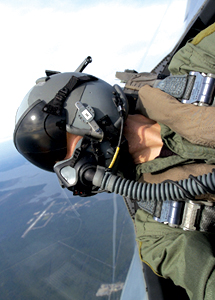INDIAN ARMED FORCES CHIEFS ON OUR RELENTLESS AND FOCUSED PUBLISHING EFFORTS

SP Guide Publications puts forth a well compiled articulation of issues, pursuits and accomplishments of the Indian Army, over the years

"Over the past 60 years, the growth of SP Guide Publications has mirrored the rising stature of Indian Navy. Its well-researched and informative magazines on Defence and Aerospace sector have served to shape an educated opinion of our military personnel, policy makers and the public alike. I wish SP's Publication team continued success, fair winds and following seas in all future endeavour!"

Since, its inception in 1964, SP Guide Publications has consistently demonstrated commitment to high-quality journalism in the aerospace and defence sectors, earning a well-deserved reputation as Asia's largest media house in this domain. I wish SP Guide Publications continued success in its pursuit of excellence.
Operations - Where Eagles Dare

What are the attributes of a military pilot? Not just grit, determination and commitment to mission accomplishment even at the peril of one’s life, but also execution of the task in a cool, calm, collected and alert frame of mind.
First indo-pak war, may 1948—The Indian Army garrison in Leh is in a grim and desperate situation, with Pakistani troops literally knocking at its doors from Khaltse in the Northwest and Khardungla in the Northeast. Reinforcement from the air urgent but the IAF’s only transporter, the DC-3 Dakota, is neither modified to fly at the en route heights nor equipped with deicing system. Fully aware of the risks, Air Commodore (Baba) Mehar Singh lands his Dak with army reinforcements at the improvised air strip at a height of 10,700 ft (at that time, the highest in the world). More sorties follow after the first historic attempt. Ladakh is saved.
Sino-indian conflict, november 1962—The Chinese declare a unilateral ceasefire after occupying large tracts of territory in the North East Frontier Agency. But in withdrawal, they leave a large number of wounded Indian soldiers who have to be heli-lifted from Tawang to Tezpur. Air Force Station Tezpur has newly inducted Mi-4s but hardly any trained pilots. The lone Flight Commander is down with raging fever but his is a life saving mission. He takes with him a brand new pilot officer (PO) posted to the collocated Toofani fighter squadron who has not even touched the flying controls of a helicopter, leave alone fly it. With super-Herculean effort he lifts the chopper past the transition, hands over the controls to the young PO, Fly it like a conventional fixed wing aircraft and take me to Tawang. Yes, sir. But where is Tawang? queries the PO. Looking at his now half-unconscious captain, he knows there will be no answer. Gingerly picking up a million-map from the floor of the cockpit, he orientates himself and map-reads his way to Tawang. The 45-minute journey in a state of feverish slumber rejuvenates the ailing captain to a degree that he manages to land without any mishap at the high-altitude helipad. Mi-4 can take only nine passengers. But the line is long and time-criticality for evacuation is such that 18 seriously wounded soldiers come aboard. The overloaded Mi-4 is incapable of a hover take-off from that altitude. The captain lines up at the far end of the helipad, opens full power and sprints down the slope, flinging the heavily laden chopper into the yawning gap below. The plunge helps the chopper quickly pick up safe flying speed, preventing it from crashing into the valley floor (a ski-jump in reverse!). Evacuation is successful.
Indo-pak war, 1971—In response to Pakistan General Yahya Khan’s declaration of war against India and the PAF’s pre-emptive strikes against IAF bases in the western sector on December 3, 1971, the IAF launches punishing across-the-board retaliatory strikes against major PAF bases. On a wintry evening on December 4, an Eagle formation of four Sukhoi-7 fighter bomber aircraft takes off from Rajasansi airfield at Amritsar and heads for the second time towards the target: a top secret PAF air base at Shorkot Road, tucked away deep inside the enemy territory. Smug in the knowledge that the newly constructed air base is deceptively concealed, the enemy is taken by total surprise during the first forenoon strike by the same formation and pays a heavy price in terms of aircraft destroyed. Flying at ultra-low level in trying to once again approach their target stealthily, the Eagles, however, know that the enemy this time around would be better prepared. And so it is. Setting course from the Initial Point, they see the sky light up with ack-ack barrage over the target still 25 km away. It is like going to a wedding reception, albeit a lethal one, thinks Eagle One. However, undeterred by the enemy’s 100- plus air defence guns, spewing their deadly ammo with tracers, he uides the formation for a pre-planned coordinated attack. Pull up, pull up now! he orders for the attack. So intense is the barrage that Eagle 4 is hit in the pull up itself, but the other three engage their respective ground targets successfully. Not only that, they gather again and turn around for the second attack which also goes through without any further mishap. On the return leg, the formation is engaged by the enemy’s Sabre interceptors lying in wait for the ambush. But once again, good evasive tactics and the now gathering darkness help the formation to evade the interceptors’ idewinder missiles and make a successful get away. Eagle 4, who has to eject out of his crippled aircraft, later makes a bold attempt at breaking out of the enemy’s POW camp in Islamabad.





